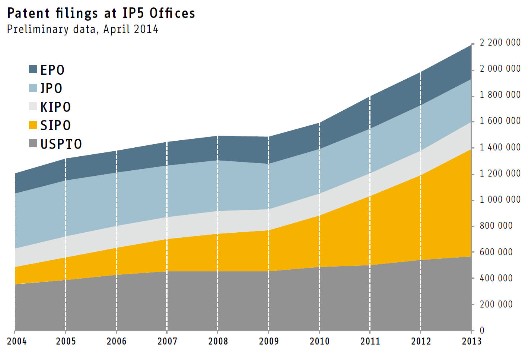
IP5 Offices
The IP5 Offices and the Growing Collaboration Between Them
Editor’s Note: Beginning with this edition, we will be running a new column comparing the formal and legal requirements for filing and prosecuting applications in the IP5 patent offices. With each issue, readers will learn the differences between the offices on a single topic, with the intention that a truly international application can be drafted. In this inaugural column, we introduce the IP5 Offices and discuss their ongoing efforts toward harmonization.
The “Five IP Offices” (IP5 Offices) is a forum of the five largest intellectual property (IP) offices in the world—the European Patent Office (EPO), the Japan Patent Office (JPO), the Korean Intellectual Property Office (KIPO), the State Intellectual Property Office of the People's Republic of China (SIPO), and the United States Patent and Trademark Office (USPTO). Presently, the IP5 Offices together handle about 80% of the world’s patent applications, and 95% of all work under the Patent Cooperation Treaty (PCT).1 Patent filings in the IP5 Offices have also increased rapidly over the past few years. Nearly 1.9 million patent applications were filed at the IP5 Offices in 2012, representing a growth of 11% over 2011. And in 2013, a total of 2.2 million patent applications were filed in the IP5 Offices, which is an increase of 10.6% over 2012. Although the growth among these IP5 Offices has not been equal over the years, there is general movement towards greater patent filings worldwide. Preliminary data from the IP5 Offices show that while the number of patent filings in 2013 in the USPTO, the KIPO, and the EPO has increased moderately from 2012 (5.3%, 8.3%, and 2.8%, respectively), and the JPO essentially had a decrease in filings of 4.2%, the SIPO has had a whopping 26.4% growth over 2012. The chart below shows the continuous rise in global patent filings, especially Chinese applications.

The majority (85%) of the patent filings in the SIPO in 2013 came from applicants who are resident in China. In comparison, only 51% of patent applications filed in the USPTO are by U.S. applicants, and only 35% of patent filings in the EPO are by applicants who are resident of the EPO region. The increased filing in the SIPO is in line with the growing investment in research and development in China. Many of the patent applicants from China are also increasingly filing abroad—there was a 10.8% and 16.2% increase in patent filings in the USPTO and the EPO, respectively, in 2013 by applicants from China. Residents of the Republic of Korea are also increasingly filing abroad, with a 14.0% and 12.1% increase in patent filings in the EPO and the USPTO, respectively, in 2013 by applicants from Korea.
While the growing trend seeking greater IP protection creates new opportunities for innovation and development worldwide, the increase in patent filing has resulted in an ever-increasing backlog of patent applications in the IP5 Offices. The backlog largely results from innovators filing for patent applications on the same technology in multiple Offices in parallel to protect their IP in multiple markets. The large growth in patent filings in the IP5 Offices demonstrates the need for greater collaboration and work-sharing between the IP5 Offices to reduce redundancies in the international patent system. Over the past few years, the IP5 Offices have been cooperating progressively to improve efficiency and quality of examination, and to eliminate duplication of work at each Office. The creation of the Patent Prosecution Highway (PPH) is one example of the exchange of information among the Offices and increased collaboration between them. More cooperation in the form of shared search and examination work, better access to prior art documentation, and tools for sharing results is in the works to eliminate redundant work and to improve quality and efficiency of patent examination worldwide.
Each issue of the Full Disclosure newsletter will explore the current similarities and differences in the laws and filing requirements of the IP5 Offices, and the continuing efforts by the IP5 Offices to harmonize their laws and practices to more efficiently and effectively integrate the global patent system. Although the IP5 Offices are striving to harmonize the formal and legal requirements for applications filed in the individual offices, there are still differences that can be more easily accommodated with a little extra planning. See you next edition!
1 The statistical data in this article are courtesy of the Five IP Offices (http://www.fiveipoffices.org).